SC Rewind: Derby Heritage
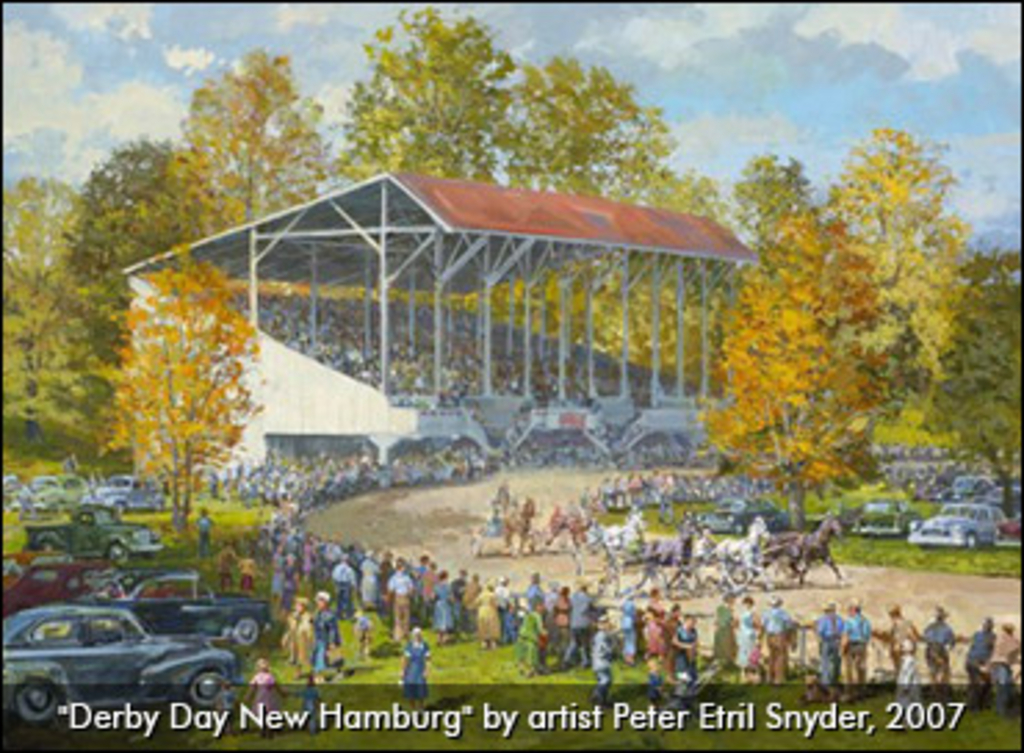
In this week's Rewind Robert Smith recalls the humble beginnings of what has become one of the sport's headline events in Canada. He traces the start up of The Canadian Pacing Derby nearly 80 years ago when small town racing was a popular pastime.
Almost 80 years have passed since the first Canadian Pacing Derby was held on August 12, 1936. It was not held in Toronto or Ottawa or any other large metropolitan area. No, its birthplace was the then small town of New Hamburg, Ontario; a beautiful little spot located in Waterloo County, midway between Kitchener and Stratford. What it lacked in size, it more than made up for in all other aspects. The town track, located at Fountain Park near the banks of the Nith River, was a picturesque spot and was blessed with one of the finest half-mile ovals in the Province. It seemed like a perfect spot and for parts of three decades it certainly was.
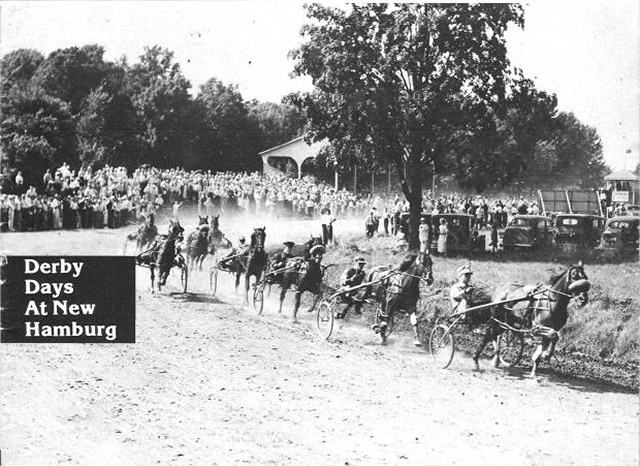
Shown above is a great view of the 1937 Canadian Pacing Derby at New Hamburg, Ont. This is a cover shot from the August 8, 1984 issue of The Standardbred when I gave a three-part history of this great race and its traditions. The leading horse is Peter Chilcoot owned by the Hon. Earl Rowe and driven by Clint Hodgins who went on to national stardom. The background view speaks volumes about the yesteryears of our sport.
The Derby was conceived by a group of caring individuals, most of whom had no actual ties to harness racing beyond their love of the sport and their desire to see it prosper. One person who did have "horse" connections was believed to have been a major factor in seeing that the plan was put into action. That man was London hotelier Alex Parsons who at the time owned a number of horses, then trained by the legendary Wm. Herbert. He reportedly planted the idea and even put up some guaranteed money to see that the annual event would happen. He had proposed his idea to folks at the London track but the necessary groundwork apparently was never accomplished.
By the time the 1936 racing season was underway the newly organized New Hamburg Turf Club was formed and many meetings had been held; most of the "hot stove" variety. A local feed store owner, a butcher from the nearby hamlet of Baden and a New Hamburg medical doctor were among the founding members. Dr. T.C. Kilpatrick was the Club's first president and once modestly told me "I guess I got the job because nobody else wanted it." The doctor, while never owning actual harness horses, had often used his trusty driving horse in a cutter to make house visits in rural areas when the roads were drifted in.
The date of Thursday, August 12 was chosen as the "Big Day" and plans were made for a full afternoon of racing. Although the facilities were less than perfect, a great day of racing ensued in spite of limited toilet facilities and sulphur drinking water. A field of eight of the area's finest pacers was assembled and the first ever Canadian Pacing Derby began. The first Derby purse was a huge $1,275!! (that's almost $22,000 in today's dollars). A crowd estimated at 6,000 crowded into the grandstand and every other spot including the infield and the day was soon judged a success. Reportedly before the day was over, an announcement was made that the second Derby was already in the works!
In the first heat Peter Chilcoot, the property of The Hon. Earl Rowe was the winner, pacing the fastest heat of the day in 2:07 flat. However from that point on, it was the eventual winner Better Times scoring in the next two heats. The winning horse's performance was not too much of a surprise as he had beaten many in the field leading up to this day. The week previous at Kincardine and just prior to that at Goderich, many of the same horses had followed him home.

Better Times was owned by Mr. J.S. Koch of London and trained and driven to victory by a young Floyd Milton of Drumbo, Ont. Mr. Milton had helped in the shaping and organization of the first Derby race as most of the committee members were enthusiastic but for the most part untrained in staging a race meet. Incidentally the aforementioned Alex Parsons had three entrants in the first Derby. While he was denied victory on this day, he would bask in the winner's circle festivities many times both as a winning owner and a presenter to other jubilant victors. He had the rare privilege of having entrants in the very first and last Derby at 'Derby Town'.
Any mention of the history of The Derby and its great successes through the years would not be complete without giving due credit to long-time organizer and super promoter Earl Katzmeier, known throughout the land simply as "Katzie". Reportedly in the early years he went door to door in the New Hamburg area asking for donations to add to the purse money. He wore a badly worn trench coat and graciously accepted donations as small as 25 cents! He attended every local race meet and handed out flyers and made pitches over the PA system whenever he could. He made the Derby go.
From this day forward the race went on for a total of 21 years and 22 major races. It soon became Ontario's biggest single race day of the year and so it remained until the sport changed in many ways. At one time it was the race by which all others were judged. The Derby was contested each year after the inaugural despite the War Years which forced the cancellation of many small town race days. The purse rose steadily and reached its highest peak in 1949 when it hit $5,000. The decade of the 1940's was a great era of racing and many tremendous Derby Days were held in front of standing room only crowds. The greatest "Hero" to emerge from these unforgettable years was The Count B, who won 4 Derbys from 1944 thru 1948. This memorable horse is buried at Fountain Park and a granite shaft marks his final resting place near the finish wire where he thrilled so many fans.
The Final Derby
In 1957 the Derby was able to draw only four starters and the decision was made to end this great race at New Hamburg. Changes in the sport including many top horses racing in the U.S. made it very difficult to attract a respectable field. The final winner was a young gelding named Captain Wright, driven by Vic Rowntree and owned by The Armstrong Bros. of Brampton who were then fairly new in the sport. They of course went on to greater heights with the Armbro name becoming an Internationally known and respected symbol of excellence in the sport. Included in the final field was Keith Waples who piloted Jay Creed to a second place finish.
The Derby is Reborn
In 1965 the Derby was revived and staged at Greenwood Raceway in Toronto. It was won by Jerry Hal, just a three-year-old at the time but obviously equal to the task for owners John and Audrey Langford of Chatham. For the first time ever it was at a distance of other than one mile with Jerry Hal completing the 1-3/16 miles in a track record time of 2:27.2. The winning horse was driven by U.S. horseman Waldo McIllmurray and expertly groomed by Keith Quinlan, originally from Midland, Ont.
In 1967, which happened to be Canada's centennial year, the Derby was the scene of Ontario's first ever two-minute mile. The huge crowd on hand were the recipients of this momentous event as Good Time Boy paced down the long Greenwood stretch stopping the timer in 1:59.4 under the urging of Quebec-born reinsman Jimmy Larente. The owners were the Gray Bros. of Providence, Rhode Island and the aforementioned Alex Parsons. Finishing second and third were members of the Wm. H. Herbert stable with Dean Herbert (Jack Herbert) second and Replica Herbert (Wm. Wellwood) third. By this time the Derby's purse had reached its highest point to date when $18,900 was up for grabs. It is interesting to note that Jack Herbert, runner up driver on this day was a groom at the inaugural Derby 31 years earlier.

Jimmy Larente and Good Time Boy enjoy the moment as Ontario racing recorded its first "Miracle Mile" in the 1967 Derby.
The Canadian Pacing Derby has been held each year since its 1965 revival and goes postward with eliminations this evening Saturday, August 29, and the final on September 5th. A number of pictures further tell the early tales of this tradition-laden race: one of the great gems of Canadian harness racing's past.
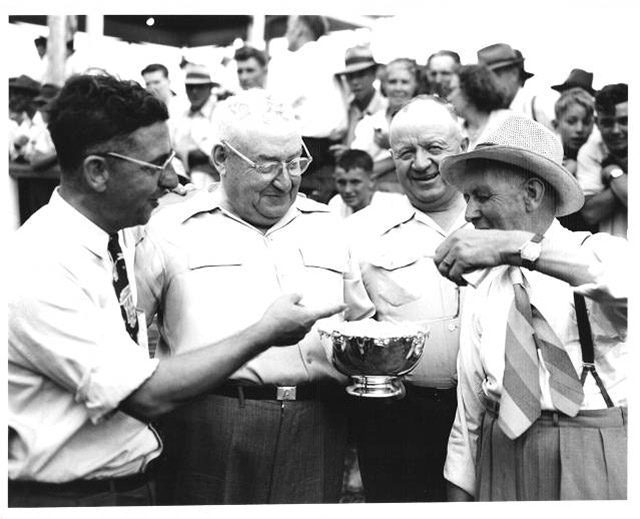
Derby personalities gather for a light hearted moment during the 1949 race day. From left is Jack Parks London Free Press racing columnist, Alex Parsons (owner of The Diplomat, that year's winner), James Brown (owner of The Count B 1948 winner) and Earl "Katzie" Katzmeier, long-time Derby promoter. (LFP Photo)
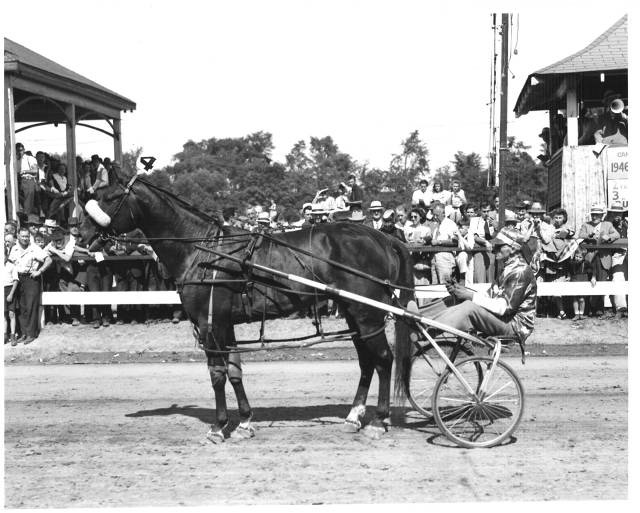
In 1946 Blue Again was the winner in three straight heats. His fastest winning time of 2:04 1/2 was an all time Derby record which stood as the best of all 22 races held at New Hamburg. The winning driver shown here was Harold Wellwood, then 40 years of age. Harold's winning mile set a new track record and netted him $100, a prize that had been unclaimed for many years. Blue Again was owned by R. W. Leatherdale of Windsor, Ont. After the record setting mile Harold allegedly said "I'm never going to reset my stopwatch because it's unlikely that I'll ever go this fast again." (LFP Photo)
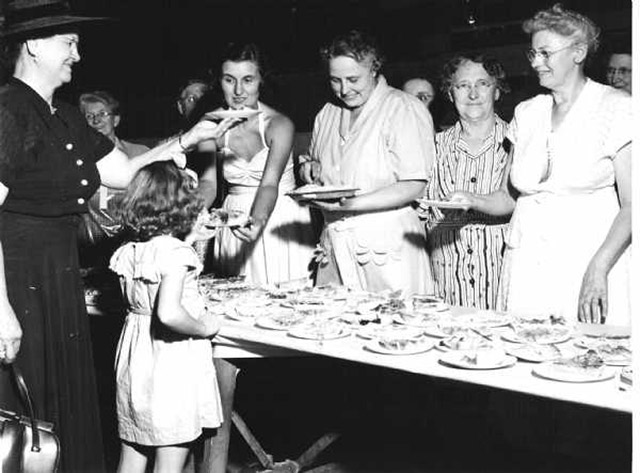
Derby Day was not all about racing. The New Hamburg folks were widely known for the great meals served on race day. What meal was complete without a piece of homemade pie served by The New Hamburg Women's Institute? (LFP Photo)

A page from the final Derby day program shows the list of event winners while held at New Hamburg


The butcher you mentioned in
The butcher you mentioned in your article is my Grandfather, Edwin Tout. He co-owned a couple of horses with Mr. Litt all those years ago. Sometime in the early 40's, my Dad helped with some fencing at the track. I remember Dad telling me that they straightened and re-used all the nails during the build.
I neglected to mention that
I neglected to mention that in 1949 the official name of this race was changed from The Canadian Pacing Derby to the Canadian Pacing And Trotting Derby. That year horseman Clarence "Shorty" Lockhart of Collingwood entered his trotting mare Make Believe as she was having a great year beating most of her competition including pacers. While his idea may have been well founded, the outcome was less than successful. She finished 11th in the first heat, 9th in the second heat, and then the decision was made to scratch her in the third. To my knowledge this was the only time in this race's long history that a horse of the trotting gait was entered.
I have often thought that there should be a place in the Hall of Fame for the New Hamburg portion of this great race to honour those who presented all of these great days.
As Marv said, Great job I
As Marv said, Great job
I look forward to reading Rewind every week,
I enjoy reading about the sport of harness racing and
the history of our races
Great job Robert. Lots of
Great job Robert. Lots of history here and more to be added tonight and next Sat.
Keep up the good work.